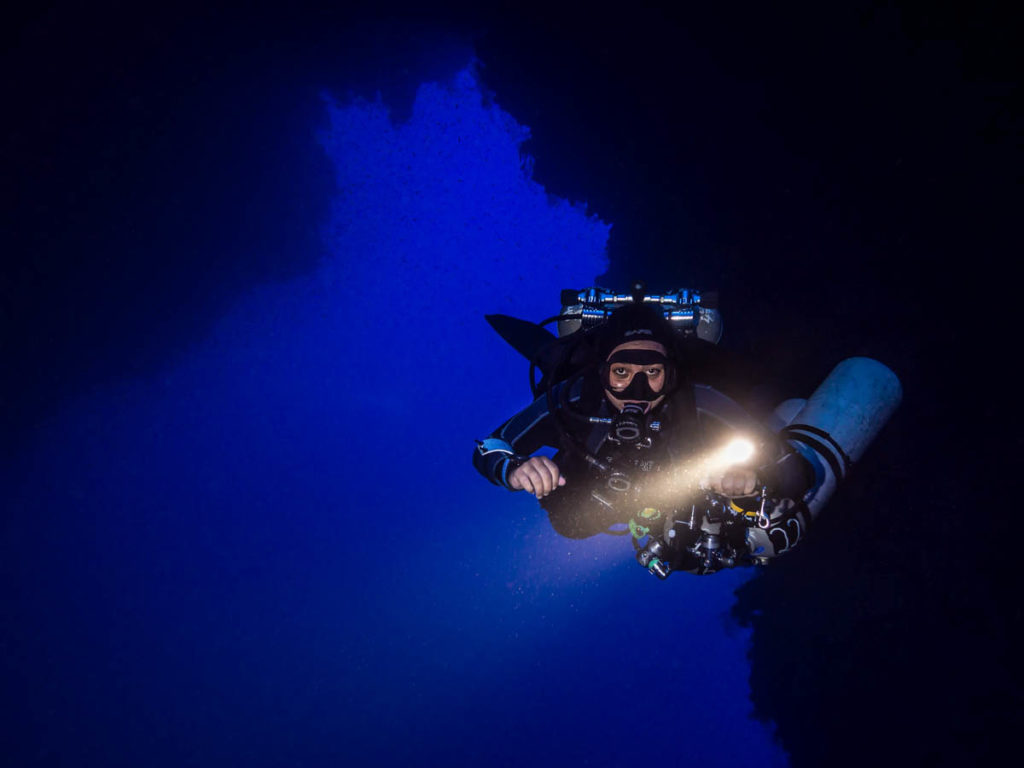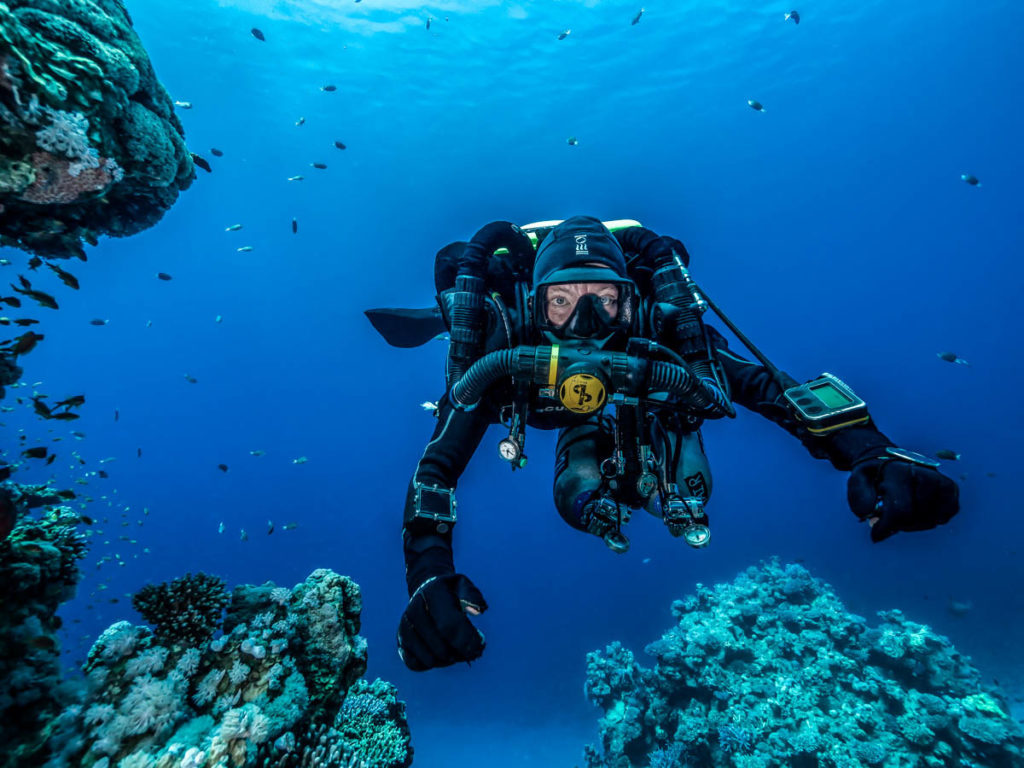The Blue Hole in Dahab is one of the world’s most famous dive sites. Divers from around the globe come year-after-year to the Blue Hole to explore its mystery.
Yet it comes with a dark history. It’s been renowned as the most dangerous dive site in the world, with common internet searches ranging from “Blue Hole Dahab bodies” to “Blue Hole Dahab Deaths”. Some people even go as far as to say that it’s cursed.
So what is it that puts this dark cloud over such a popular dive site? And is the Blue Hole really so dangerous?
Let’s dive in!
Located a couple of kilometres North from the main town of Dahab, the Blue Hole is a sinkhole-like formation in the reef surrounding the shore.
It was first explored by Israeli divers during the Israeli occupation of Sinai in the 1970s, and has since attracted more and more divers year-on-year.
Unfortunately, the Blue Hole has become a place subject to many diving fatalities. Estimates suggest anywhere between 130-200 deaths have occured since the 1980s, although there are no official statistics.¹ ² ³
However, these fatalities are not the result of the dive site itself. The Blue Hole is arguably very safe.
But before delving deeper into this theme, let’s first talk about the dive site itself.
The Bells
“The Bells” is a common entry point for recreational divers, located a couple of hundred metres North of the Blue Hole. It is a chimney-like formation in the reef wall which you can enter from the shallows, bringing you out again at about 28 metres.
It gets its name from tanks banging on the walls of the reef, sounding like ringing bells.
Divers enter the water at the Bells, and then follow the reef right shoulder to the South where they eventually reach the outside of the Blue Hole. From here, you can enter the Blue Hole via the “Saddle”, which is a dip in the outer reef wall to about 6 metres, allowing you to cross over.
This is the standard way to dive the Blue Hole Dahab, recreationally.
The Arch Blue Hole
The Arch is arguably the infamous part of the Blue Hole in Dahab. It is an opening in the outer reef wall of the Hole which begins at 56 metres, with the bottom levelling off at 120 metres.
The Arch provides absolutely stunning views for divers. When the morning light floods through it from the East, it is illuminated like some sort of magical entrance or tunnel, alluring divers to enter.
The Arch should only be dived as a technical dive, as its depth makes it unsuitable for single tank recreational diving.
The classic route is to enter the Blue Hole and descend directly to the opening of the Arch. From here, you can peacefully explore the ceiling of the Arch – covered in corals – while enjoying the view of the expanding deep blue depths below. After exiting the Arch, you can then ascend, following the reef wall right shoulder, and begin their decompression stops. Finally, you can cross back over the Saddle, re-entering the Blue Hole.
Why is the Blue Hole of Dahab so Dangerous?
Breaking news – the Blue Hole, Dahab, is not dangerous!
That’s right. The dive site doesn’t have any inherent risks and is actually a relatively well-protected area with regards to currents and waves.
What is dangerous, however, is underestimating a dive site and diving beyond recommended limits. This applies to all dive sites – not only the Blue Hole.
The main risks of diving deeper than 40 metres are:
- Increased inert gas uptake in the body’s tissues, requiring longer decompression stops during the ascent to avoid decompression sickness (DCS)
- Increased gas consumption, due to higher atmospheric pressure
- Inert gas narcosis (the narcotic effect of breathing certain gases under high pressures)
- high gas density if diving on air which can lead to CO₂ build up among other things
With the correct training and equipment, however, these risks can be greatly mitigated.
Technical divers are trained in the use of mixed-gas diving, in which helium is used to offset narcosis and adjust gas density, while oxygen-rich gases speed up decompression. Not to mention all the other emergency procedures, critical drills and dive planning that are taught in tec diving courses.
In the same way flying an aeroplane carries many inherent risks, which are mitigated through training courses and experience, so too does diving deeper than 40 metres, which is offset through technical dive training.
The majority of fatalities in the Blue Hole Dahab, are the result of recreational divers attempting to swim through the Arch on a single tank. This is the equivalent of an untrained pilot attempting to fly a plane – and no one would be surprised when things went wrong there…
The Arch begins at a minimum depth of 56 metres, and is estimated to be around 27 metres long. The classic scenario usually goes one of two ways:
- The recreational diver manages to swim through the Arch but has breathed so much air that they now don’t have enough left to finish their decompression stops. They surface and the symptoms of DCS begin to appear.
- When swimming through the Arch, the recreational diver is overcome by the effects of inert gas narcosis, causing them to become confused and dive even deeper without realising. They inevitably become narked, get an oxygen toxicity or/and run out of air and drown.
Events like this are awful. But they are also highly avoidable.
If you stay within your limits, then much of the risk of diving the Blue Hole of Dahab is removed.
Extreme Sports, Higher Risks
That being said, there are a few exceptions to the fatalities. There have been some recorded cases of high profile technical divers losing their lives in the Blue Hole Dahab.
However, this again has nothing to do with the dive site.
Many of these types of fatalities occurred during extreme technical dives.
Technical diving is an extreme sport. And within technical diving, there is also a scale of extremity, relating to the types of dives being done. A 40 metre dive, for example, carries fewer risks than a 200 metre dive.
That’s not to say that technical diving at the extreme end of the scale is some form of Russian roulette – the dives are still highly planned and the risks are calculated. Rather, it simply means that the overall inherent risk of the dive is higher.
Climbing Mount Everest, for example, carries a higher risk than climbing Mount Kilimanjaro. And it is during these “Mount Everest” type of dives in which fatalities have occured in the Blue Hole.
As with any extreme sport, such fatalities can unfortunately be expected at the cutting edge. This, however, has nothing to do with the Blue Hole itself.
Blue Hole Dahab: A Deep Swimming Pool
Contrary to all the myths of inherent risks and Bedouin curses, the Blue Hole is actually very safe. In fact, for technical divers, it’s arguably one of the safest dive sites in the world.
The Blue Hole is essentially a very deep swimming pool. Because of its outer reef wall, it is completely protected against currents, with waves being relatively calm too. The visibility is also normally very good as well, reducing the chance of buddy separation and navigational issues.
Similarly, the Egyptian Chamber of Diving and Water Sports (CDWS) have placed certain rules and regulations in place in the past few decades to increase dive centre safety as well as prevent fatalities.
These factors make the Blue Hole a very safe and useful training environment for technical divers.
On top of this, the Blue Hole Dahab is a great dive site in general for everyone. From technical and recreational divers, to freedivers and even snorkelers, the Blue Hole has something to offer everyone. With its crystal clear waters, multi-coloured corals and abundance of marine life, it satisfies all levels of experience.
Overall, if you’ve been wondering about the Blue Hole Dahab, then wonder no longer – get in contact with us to arrange guided recreational or technical dives, as well as courses.
Learn more at: https://lagona-divers-technical.com
References
- https://www.theguardian.com/world/2017/aug/26/blue-hole-red-sea-diver-death-stephen-keenan-dahab-egypt.
- https://www.memphistours.com/Egypt/Egypt-Wikis/red-sea-and-sinai/wiki/blue-hole.
- https://www.spiegel.de/international/zeitgeist/the-blue-hole-in-the-red-sea-is-the-deadliest-dive-









